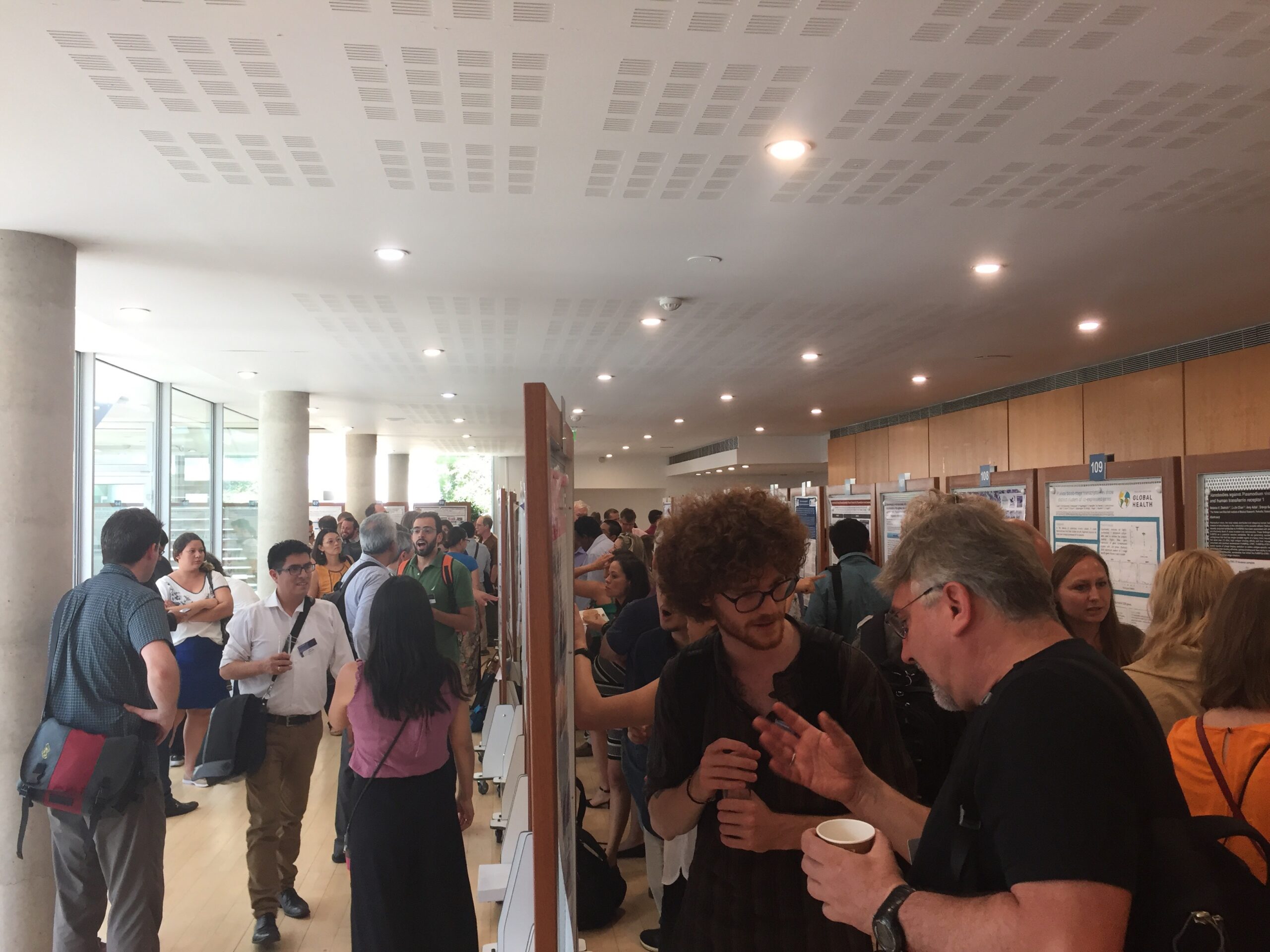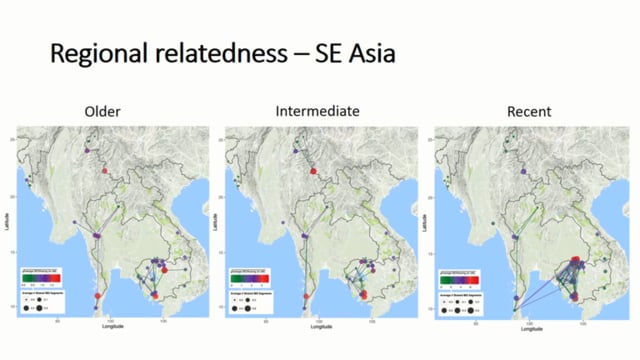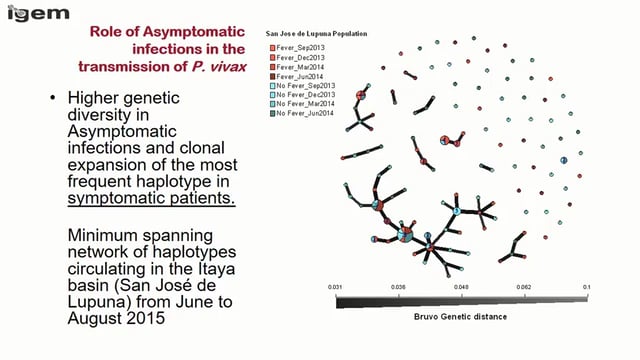7th International Conference on Plasmodium vivax Research (ICPvR) – 2019: Day 2
Thursday, 27th June 2019
Published: 28/06/2019
This report is brought to you by the MESA Correspondents Emma Collins, and Kate Twohig. Senior editorial support has been facilitated by Hernando del Portillo.
THEMES: THEMES: Basic Science | Epidemiology | Health Systems
MESA Correspondents bring you cutting-edge coverage from the 7th International Conference on Plasmodium vivax Research
Day 2: Thursday, 27th June
The main focus of the presentations on day two of the 7th International Conference on Plasmodium vivax Research was on laboratory exploration of P. vivax biological characteristics, parasite development stages and host-parasite interaction. There was a lively poster session during the lunch period and a conference dinner at the magnificent Musée d’Orsay.
Plasmodium vivax sporozoites and liver stages (hypnozoites, invasion, vaccines, immunity)
We started the day with an excellent talk from John Adams (University of South Florida, United States) presenting his investigation to find the essential genes involved in activation and infectivity of P. vivax sporozoites in order to find a target for inhibition. He spoke about using phylogenetic genomics information from P. falciparum, P. berghei and Toxoplasma as a proxy to study essential genes in P. vivax. He emphasised that the ideal targets would have the following characteristics: present in blood stage parasites, expressed in multiple life stages and not transcriptionally repressed. He also described implementation of semi-automated HTP methods for quantitative analysis of live sporozoite motility, traversal cell assays and inhibition of liver stage development for drug and vaccine development.
Erika Flannery (Novartis Institute of Tropical Diseases, United States) spoke about the continued uncertainty in the mechanisms underlying P. vivax relapse and radical cure within the liver. She demonstrated the importance of using schizonticidal drugs before adding hypnozoicidal drugs to remove confounding factors in the studies of hypnozoite biology and demonstrated that hypnozoites are transcriptionally silent and can be reactivated. She described techniques for drug discovery using the in vitro culture of P. cynomolgi, which permits the use of reverse genetics to create transgenic lines, the use of iPS cell lines capable of differentiating to hepatocytes as an unlimited source for in vitro culture of hypnozoites, and of liver chimeric humanised mouse models to assess if drug exposure at different infection stages could prevent or halt hypnozoite formation and activation.
Arturo Reyes-Sandoval (Jenner Institute, University of Oxford, United Kingdom) described challenges for vaccine development for P. vivax, including the life cycle complexity and genetic diversity across parasite populations. The consequences of these challenges are that a new vaccine would ideally target multiple components and stages. He demonstrated the use of transgenic P. berghei parasites expressing P. vivax vaccine candidates as surrogate markers in vaccine antigen screening and prioritization. Trials of three main vaccine candidates, Pv CelTOS, PvTRAP and PvCSP (PvR21) demonstrated that the PvCSP utilising HepB S VLP was the most promising, leading to 100% protection in two mice models; thus, paving the road for near future clinical trials. Further improvements using a combination of proteins (e.g. PvR21 with TRAP) are being pursued.
Steven Maher (University of Georgia, United States) emphasized the value of collaboration in the optimization and innovation of drug screening processes. They have harvested more than a billion sporozoites to use in hepatocyte challenge experiments and emphasized the importance of implementing semi-automated HTP methodologies for drug screening which have allowed them to test over 18,000 compounds.
Alison Roth’s (Walter Reed Army Institute of Research) research screened large numbers of compounds for novel anti-relapse hypnozoicidal drugs in a P. cynomolgi liver model, balancing toxicity with reactivity and efficacy. Josue da Costa Lima Junior (FIOCRUZ, Brazil) discussed his characterisation of the humoral response to PvTRAP protein, finding that IgG1 was the main immune response elicited. For drug and vaccine development, generation of large numbers of sporozoites is required. Rosa Santana (Tropical Medicine Foundation Dr Heitor Vieira Dourado, Brazil) presented work demonstrating higher sporozoite production in An. darlingi, compared with An. aquasalis. Dennis Shanks (Australian Defence Force Malaria, Infectious Disease Institute, and University of Queensland, Australia) completed the morning session with a presentation of the correlation between blood transfusion with P. vivax hypnozoite initiation for infection relapses from an analysis of historical data from US Army records. From this, he hypothesised that apoptosis of hepatocytes could be the trigger for hypnozoite activation.
Ex vivo and in vivo models to study Plasmodium vivax
Dennis Kyle (University of Georgia, United States) discussed the importance of understanding the characteristics of hypnozoites in order to discover a radical cure for P. vivax. They found that the PI4K activity varies between hypnozoites, generally arising between three and six days post infection, and that PI4K insensitivity may be a marker for hypnozoites. Their drug screening found that Monensin is an effective drug against schizonts and hypnozoites and mentioned screening several different libraries such as MMV libraries and ReFRAME, from which they have identified 14 new compounds.
For decades Bruce Russell (University of Otago, New Zealand) has been trying to culture P. vivax, finally attempting to replicate a 1981 study to culture P. cynomogi as a proxy. He failed to culture with common P. cynomolgi strains B and M but had great success with the Berok strain. This technology has been transferred to many different laboratories worldwide and is available upon request. The ability to culture one strain and not others led him to investigate the differences in reticulocyte invasion between the strains. He recalled the audience´s attention about misconceptions of reviewers on P. vivax research and the importance of pursuing efforts to continue emphasizing the fundamental biological differences between P. falciparum vs P. vivax.
A comprehensive talk on how a model of P. cynomolgi infection in rhesus macaques can be used to further elucidate insights into relapse infection biology was given by Chet Joyner (Emory University, United States). He reiterated that although this model provides a similar context in which to investigate P. vivax, noting the similarity in observed clinically silent infections, we don’t know the full extent to which these parasites differ. He provided evidence using changes in the host transcriptome that infections are modulating B cell related immune responses.
In the absence of P. vivax cultures or in vivo models, Rob Moon (London School of Hygiene and Tropical Medicine, United Kingdom) described how transgenic P. knowlesi can be used as an effective model for P. vivax vaccine candidates. He has refined the mutagenesis of P. knowlesi using CRISPR cas9 to substitute the P. knowlesi Duffy binding protein (DBP) for the vivax DBP and also knocked out the beta and gamma DBPs. This swap provided insight for the parasite host preference, as the transgenic parasite had more affinity for human cells than macaque cells.
Anne-Marie Voorber-van der Wall (BPRC, The Netherlands) successfully described her development of a double reporter line of P. cynomolgi. She inserted a green fluorescent protein (GFP) at a constitutive promoter so it was expressed in all parasites while inserting mCherry to be regulated by Lisp2, which has recently shown to mark early liver stages in P. cynomolgi. The transgenic parasite exhibited no loss of fitness, and after 6 days hypnozoite development could occur. This transgenic model is an exciting new tool that can be used to study compounds that trigger hypnozoite development and allowed the first unequivocal evidence of true hypnozoite reactivation.
Catlin Cooper (University of Georgia, United States) spoke about her efforts to create a proxy for P. vivax continuous culture. She achieved long-term culture of the P. cynomolgi Berok RLV9 strain, while improving sustainability using human serum. Florian Bach (University of Edinburgh, United Kingdom) reported the results of the first blood-stage infection trial from which he hypothesised that P. vivax malaria reprograms the immune system to reduce inflammation and minimise pathology. He hopes to investigate this idea further by monitoring the immune responses of volunteers with repeated infections. Letusa Albrecht (FIOCRUZ and UNICAMP, Brazil) compared RNA of parasites with weak and strong levels of rosetting and demonstrated that there are over 150 genes involved in the process, with around 16% of them associated with membrane proteins. Moreover, she observed increased rosetting capacity observed in sexual parasite stages. Gabriel Rangel (Harvard T.H. Chan School of Public Health, United States) investigated whether there was further discrimination in reticulocytes choice for parasite invasion and discovered that P. vivax had a high preference for and survived better in SLC12A6+ cells.
Plasmodium vivax blood stages (invasion, immunity, pathogenesis and vaccines)
In 1976, the first study that described the protection of Duffy blood group negativity against P. vivax was published, and today Peter Zimmerman (Case Western Reserve University, United States) presented contradictory evidence of P. vivax infections in Duffy negative individuals from Madagascar. A study carried out in Ampasimpotsy district illustrated a decrease in prevalence of P. vivax infections in Duffy negative individuals and lower levels in Duffy heterozygotes, suggesting that it still has a protective effect. However, the mechanism of entry into Duffy negative cells remains unknown. Given the finding of Duffy positive red blood cells in the bone marrow of Duffy negative individuals, he is using bone marrow cells to try developing the in vitro culture system of P. vivax and showed data of sustaining cultures for 500 days.
Innovation in P. vivax preventative interventions is limited by challenges in acquiring sufficient parasite for inoculation. Angela Minassian (Jenner Institute, University of Oxford, United Kingdom) demonstrated the implementation of the first European controlled human malaria infection (CHMI) facilities to carry out clinical trials of P. vivax. A meticulous approach following European regulations allowed the production of 190 vials of P. vivax infected blood, which she encouraged other groups to use in vaccine trials. Undoubtedly, this kind of collaboration will enable the malaria research community to accelerate the rate of breakthroughs and hopefully hasten the production of an effective P. vivax vaccine. Two different candidates of the Duffy Binding Protein are now entering in these CHMI clinical trials.
The evolutionary history of P. vivax was examined through research presented by Virginie Rougeron (French National Center for Scientific Research, CNRS, France) on the relatedness to the P. vivax-like parasite that infects African great apes. Through genomic characterization from whole genome amplification and short read illumina sequencing, two distinct clades for P. vivax and the vivax-like parasite are determined, including further discovery of two vivax-like sub-lineages.
With a panel of monoclonal antibodies from the first in-human trials of leading P. vivax vaccine candidate, the Duffy-binding protein (PvDBP), Tom Rawlinson (Jenner Institute, University of Oxford, United Kingdom) used growth inhibition assays to characterise the invasion inhibitory properties in a transgenic P. knowlesi parasite line.
Current research has identified only two red blood cell host receptors that mediate P. vivax parasite invasion: the Duffy Antigen Receptor for Chemokines (DARC) and the reticulocyte restricted transferrin receptor (TfR/CD71). The presentation by Usheer Kanjee (Harvard T.H. Chan School of Public Health, United States) provided insight into the functional impact of these proteins, showing that DARC knockout and TfR mutants individually reduced P. vivax parasite invasion. Promising reductions in P. vivax invasion from a SLC4A1 knockout study also called attention to a possible species-transcendent host factor.
We heard three turbo talks this afternoon, the first was from Camille Roesch (Institut Pasteur, Cambodia) who demonstrated the functional impact of increased PvDBP gene copies associated with higher PvDBP gene expression, aiding the understanding of why this protein gene is amplified even in areas of low Duffy-negativity. Following on from yesterday’s presentation revealing high spleen parasite biomass, Haruka Toda (Barcelona Institute for Global Health (ISGlobal)), showed research supporting cytoadherence of uninfected spleen fibroblasts as a result of stimulation due to extracellular vesicles from infected cells.
Martha Clark (Harvard T.H. Chan School of Public Health, United States) and her flow cytometry lysis assay demonstrated that there was increased osmotic fragility associated with reticulocyte development and decreased osmotic stability during parasite maturation.
Finally, Herbert Opi (Burnet Institute for Medical Research and Public Health, Australia) spoke about how we often rely on increased antibody production to identify potential target molecules, however, we should focus more on the functional antibody response.
This report is brought to you by MESA Correspondents Emma Collins and Kate Twohig (University of Oxford) with mentoring and editorial support from Hernando del Portillo (Barcelona Institute for Global Health (ISGlobal) & Institut d’Investigació Germans Trias i Pujol (IGTP)). It is cross-posted on the MESA Website and Malaria World.
Published: 28/06/2019
This report is brought to you by the MESA Correspondents Emma Collins, and Kate Twohig. Senior editorial support has been facilitated by Hernando del Portillo.
THEMES: Basic Science | Epidemiology | Health Systems


